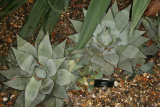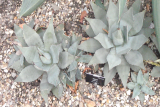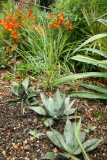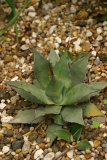Additional notes (click to expand)
Commemorative
Parry’s agave is named for Charles Christopher Parry (1823–90), an English-born, American botanist and physician. Born in Gloucestershire, he moved to New York with his parents in 1832 and was a medical student at Columbia University. At college he studied botany under John Torrey, the premier botanist of the USA, and in 1848 with the physician botanist George Engelmann, the founder of the Missouri Botanical Garden. He had his practice in Davenport, Iowa, but in 1861 he spent the summer collecting the wild fl owers of Colorado, acquiring 417 species. In 1862, he led a
collecting party which found 700 species. For the next 20 years, he spent his summers collecting in Colorado. He travelled to England (1870), where he met Sir Joseph Hooker, the director at Kew, who was later (1878) to call Parry the ‘king of Colorado botany’. He made use of both aspects of his training, as surgeon and botanist to the United States and Mexican Boundary Survey from 1848–55. He collected on the US-Mexican border in California, as well as in Colorado, Wyoming and Utah. His herbarium of 18,000 specimens is at Iowa State University, although in his lifetime he collected 30,000 specimens, 100 of which were new to science, and were an important source for Watson et al’s eological survey of California (Botany, 2 volumes; 1876, 1889). He discovered the Torrey pine,
Pinus torreyana, and the Engelmann spruce, Picea engelmannii, naming them after his botany
teachers from Columbia. Some 80 plants are named after Parry.
Oakeley, Dr. Henry. (2012). Doctors in the Medicinal Garden. Plants named after physicians. Royal College of Physicians. page 23
link
Horticulture
Agave parryi is a succulent in the Agavaceae family from the arid areas of southern North America. It is known as the hardiest of the species and survives happily outside at the Medicinal Garden. We grow it in a sunny position, in a sheltered, free draining border amongst other plants from arid zones. In less favourable conditions, it is advisable to grow in a pot to plunge into the border during summer and keep under glass over winter. It produces numerous offsets which can be potted up to increase stocks (by Clare Beacham).
Oakeley, Dr. Henry. (2012). Doctors in the Medicinal Garden. Plants named after physicians. Royal College of Physicians.
link
Arizona, New Mexico, Mexico. grasslands, oak and pine woodlands, and Arizona chaparral at altitudes of 1500-2500 metres.
http://jan.ucc.nau.edu/plants-c/bio414/species%20pages/Agave%20parryi.htm Internet Oct 2016
Pollinated by bats. Monocarpic, dies after flowering (HO).
Nomenclature
Parry's agave; mescal agave.
Other use
Heart of the plant can be baked and eaten, also young plants. Fibre from leaves. Thorns used as needles. Soap extracted from leaves. Sap can be tapped from the plant and fermented to make an alcoholic drink. Tequila is made from Agave tequilana.
http://jan.ucc.nau.edu/plants-c/bio414/species%20pages/Agave%20parryi.htm Internet Oct 2016
Geographical distribution
- Northern America, Mexico
- Northern America, South-Central U.S.A., New Mexico
- Northern America, South-Central U.S.A., Texas
- Northern America, Southwestern U.S.A., Arizona
Agave parryi Engelm.
Family: ASPARAGACEAEGenus: Agave
Species: parryi Engelm.
Common names: Parry's Agave
Distribution summary: Arizona, Texas, Mexico
Habit: Shrub
Hardiness: H3 - Half hardy; unheated greenhouse/mild winter
Garden status: Currently grown
Garden location: Arid zones (Q)
Reason for growing: Commemorative





